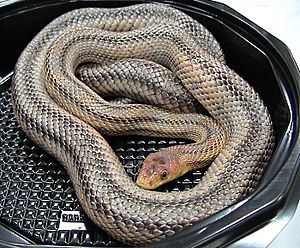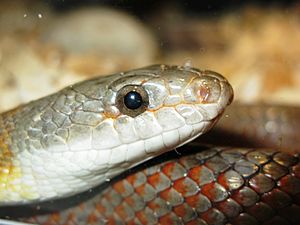Pantherophis bairdi facts for kids
Quick facts for kids Pantherophis bairdi |
|
|---|---|
 |
|
| Scientific classification | |
| Genus: |
Pantherophis
|
| Species: |
bairdi
|
| Synonyms | |
|
|
The Pantherophis bairdi is a type of harmless snake. It's often called Baird's rat snake or Baird's pilot snake. This snake is special because it's found only in the southwestern United States and nearby parts of northeastern Mexico. Scientists don't recognize any different types (subspecies) of this snake right now.
Contents
Where Baird's Rat Snake Lives
You can find P. bairdi in the Big Bend area of western Texas in the United States. It also lives in northern Mexico, in the states of Coahuila, Nuevo León, and Tamaulipas. This snake is quite shy and hard to spot in the wild.
Why It's Called Baird's Rat Snake
The name bairdi and some of its common names are given in honor of an American zoologist named Spencer Fullerton Baird. A zoologist is a scientist who studies animals.
What Baird's Rat Snake Looks Like
Adult Baird's rat snakes can grow to be about 64 to 140 centimeters (25 to 55 inches) long. Their backs can be orange-yellow, bright yellow, or a darker salmon color. They have four stripes that run from their neck all the way to their tail. Their bellies are usually gray to yellow, becoming darker near the tail.
What Baird's Rat Snake Eats
Baird's rat snakes mainly eat rodents, like mice and rats. They also hunt and eat birds. Younger snakes, called juveniles, often eat lizards.
How Baird's Rat Snake Behaves
Baird's rat snakes are generally known for being calmer and more pleasant than some other types of rat snakes.
Reproduction and Life Cycle
P. bairdi is an oviparous animal, which means it lays eggs. Adult female snakes can lay up to 10 eggs at a time. These eggs usually take about three months to hatch into baby snakes.
Where Baird's Rat Snake Prefers to Live
This snake likes to live in places that are semi-dry and rocky. These are its favorite habitats.
Other Names for Baird's Rat Snake
Besides Baird's rat snake, this snake is also known as Baird's ratsnake, Baird's pilot snake, Baird's Coluber, and the Great Bend rat snake.
About Its Scientific Classification
For a while, Pantherophis bairdi was sometimes thought to be a type of Pantherophis obsoletus because they are closely related. Scientists often group animals based on their relationships.
This snake was also often placed in a different group, or genus, called Elaphe. However, newer scientific studies that look at the DNA of snakes have shown that it belongs in the genus Pantherophis. This is why its full scientific name is Pantherophis bairdi.


